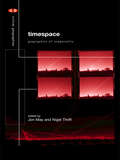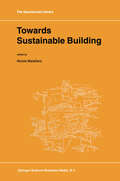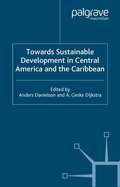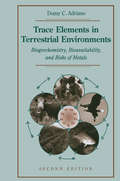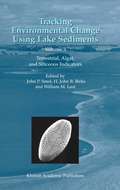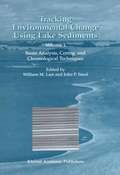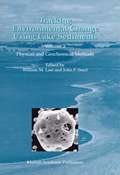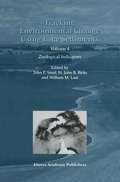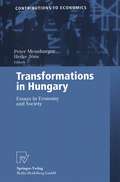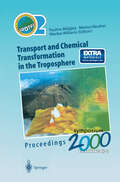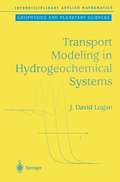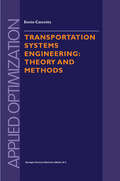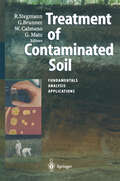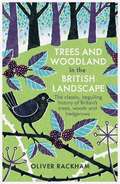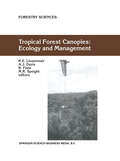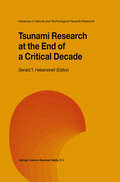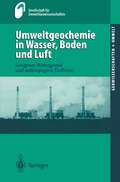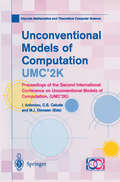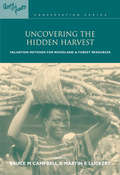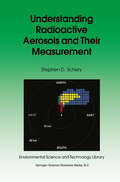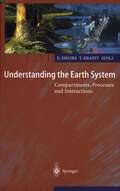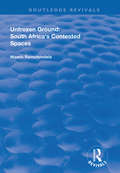- Table View
- List View
Timespace: Geographies of Temporality (Critical Geographies)
by Jon May Nigel ThriftTimespace undermines the old certainties of time and space by arguing that these dimensions do not exist singly, but only as a hybrid process term. The issue of space has perhaps been over-emphasised and it is essential that processes of everyday existence, such as globalisation and environmental issues and also notions such as gender, race and ethnicity, are looked at with a balanced time-space analysis.The social and cultural consequences of this move are traced through a series of studies which deploy different perspectives - structural, phenomenological and even Buddhist - in order to make things meet up. The contributors provide an overview of the history of time and introduce the concepts of time and space together, across a range of disciplines. The themes discussed are of importance for cultural geography, sociology, anthropology, cultural and media studies, and psychology.
Timespace: Geographies of Temporality (Critical Geographies)
by Jon May Nigel ThriftTimespace undermines the old certainties of time and space by arguing that these dimensions do not exist singly, but only as a hybrid process term. The issue of space has perhaps been over-emphasised and it is essential that processes of everyday existence, such as globalisation and environmental issues and also notions such as gender, race and ethnicity, are looked at with a balanced time-space analysis.The social and cultural consequences of this move are traced through a series of studies which deploy different perspectives - structural, phenomenological and even Buddhist - in order to make things meet up. The contributors provide an overview of the history of time and introduce the concepts of time and space together, across a range of disciplines. The themes discussed are of importance for cultural geography, sociology, anthropology, cultural and media studies, and psychology.
Towards Sustainable Building (GeoJournal Library #61)
by NicolaMaiellaroThis volume contains the extended versions of selected papers presented at the first Mediterranean Conference "Sharing Knowledge on Sustainable Building" held at the Polytechnic ofBari in December 1999, supported by the National Research Council of Italy. The publication of this book was made possible through the efforts of the contributing Authors. Other people have provided invaluable support for the conference and for the preparation of this volume; in particular, I wish to thank Antonella Lerario for providing support in the final editing of the text and images. 1 As reported in Boonstra and Rovers (200 I) , people spend a great deal of time inside buildings; therefore, decisions about design, construction, use, maintenance, renovation, demolition, reuse and recycling of buildings have a huge impact on the sustainable development of our society. Technical aspects, however, should be supported by adequate policies, developed with appropriate tools and driven by meaningful challenges. For people involved in sustainable buildings, the conceptual frameworks, studies and experiences collected in this volume, organized into three parts - "Policies", "Tools" and "Challenges" - will help to advance knowledge allowing them to adopt and more efficiently implement such innovations sooner.
Towards Sustainable Development in Central America and the Caribbean
by A. Danielson A. DijkstraSince the economic decline in the early 1980s, most countries in Central America and the Caribbean have returned to positive growth rates. The recovery often coincided with or followed extensive neoliberal reforms. The contributors to this book address the crucial question of whether these growth rates are sustainable. Several aspects of sustainability are assessed, in particular macroeconomic, social, and ecological aspects. The book includes both comparative analyses focusing on one of these aspects of sustainability, and country case studies. The conclusion is that these countries have not yet arrived at a sustainable growth path due to, for example, high levels of foreign and domestic debt, worrisome trade gaps, a lack of social integration and irresponsible exploitation of natural resources. In sum, the analysis points to serious weaknesses in the current neoliberal model, the implications of which go far beyond this particular region.
Trace Elements in Terrestrial Environments: Biogeochemistry, Bioavailability, and Risks of Metals
by Domy C. AdrianoA comprehensive reference handbook on the important aspects of trace elements in the land environment. Each chapter addresses a particular element and gives a general introduction to their role in the environment, where they come from, and their biogeochemical cycles. In addition to a complete updating of each of the element chapters, this new edition has new chapters devoted to aluminum and iron, soil contamination, remediation and trace elements in aquatic ecosystems. In short, an essential resource for environmental scientists and chemists, regulators and policy makers.
Tracking Environmental Change Using Lake Sediments: Volume 3: Terrestrial, Algal, and Siliceous Indicators (Developments in Paleoenvironmental Research #3)
by John P. Smol H. John B. Birks William M. Last Raymond S. Bradley Keith AlversonTracking Environmental Change Using Lake Sediments: Volume 1: Basin Analysis, Coring, and Chronological Techniques (Developments in Paleoenvironmental Research #1)
by William M. Last and John P. SmolTracking Environmental Change Using Lake Sediments: Volume 2: Physical and Geochemical Methods (Developments in Paleoenvironmental Research #2)
by William M. Last John P. SmolTheory Instrumentation NIR analysis of sediment samples Uses of NIRS in palaeolimnology Future perspectives Summary References Fly-ash particles. Neil Rose 319 12. Introduction A brief history Methods of extraction and enumeration Temporal distribution Spatial distribution Source apportionment The future Summary Acknowledgements References Part III: Stable Isotope Techniques 13. Application of stable isotope techniques to inorganic and biogenic carbonates. Emi Ito 351 Introduction Nomenclature and systematics of lake-water Mg/Ca and Sr/Ca ratios of lake-water of dissolved inorganic carbon (DIC) Carbonates in lake-sediments Mollusks Ostracodes Charaphytes Isotope analysis Preparation of carbonate samples for isotope analysis Conclusions Summary Acknowledgments References 14. Carbon and oxygen isotope analysis of lake sediment cellulose: methods and applications. Brent B. Wolfe, Thomas W. D. Edwards, Richard J. Elgood & Kristina R. M. Beuning 373 xi Introduction Stable isotope tracers in lake Historical development Methods Key criteria for paleohydrologic reconstruction Applications Future research directions Summary Acknowledgements References Nitrogen isotopes in palaeolimnology. Michael R. Talbot 15. 401 Introduction Nitrogen in lakes: forms and distribution Nitrogen isotopes Nitrogen isotope studies in palaeolimnology: sampling and measurement Some examples Closing remarks Summary Acknowledgments References Glossary, acronyms and abbreviations 441 Index 493 xiii PREFACE The explosive growth of paleolimnology over the past two decades has provided impetus for the publication of this series of monographs detailing the numerous advances and new techniques being applied to the interpretation of lake histories. This is the second volume in the series and deals mainly with physical and geochemical analytical techniques.
Tracking Environmental Change Using Lake Sediments: Volume 4: Zoological Indicators (Developments in Paleoenvironmental Research #4)
by John P. Smol William M. Last H. J. BirksPaleolimnology is a rapidly developing science that is now being used to study a suite of environmental and ecological problems. This volume is the fourth handbook in the Developments in Paleoenvironmental Research book series. The first volume (Last & Smol, 2001a) examined the acquisition and archiving of sediment cores, chronological techniques, and large-scale basin analysis methods. Volume 2 (Last & Smol, 2001b) focused on physical and chemical methods. Volume 3 (Smol et al. , 2001), along with this book, summarize the many biological methods and techniques that are available to study long-term environmental changeusing information preserved in sedimentary profiles. A subsequent volume (Birks et al. , in preparation) will deal with statistical and data handling procedures. It is our intent that these books will provide sufficient detail and breadth to be useful handbooks for both seasoned practitioners as well as newcomers to the area of paleolimnology. These books will also hopefully be useful to non-paleolimnologists (e. g. , limnologists, archeologists, palynologists, geographers, geologists, etc. ) who continue to hear and read about pal- limnology, but have little chance to explore the vast and sometimes difficult to access journal-based reference material for this rapidly expanding field. Although the chapters in these volumes target mainly lacustrine settings, many of the techniques described can also be readily applied to fluvial, glacial, marine, estuarine, and peatland environments. This current volume focuses on zoological indicators preserved in lake sediments, whilst Volume 3 focused on terrestrial, algal, and siliceous indicators.
Transformations in Hungary: Essays in Economy and Society (Contributions to Economics)
by Professor Dr. Peter Meusburger Dipl.-Geogr. Heike JönsDuring the first decade after the turn towards democracy and market economy, Hungary's society experienced profound changes. The book analyses related political, legal, institutional and socio-economic structures and processes in order to contribute to a further understanding of Hungary's ongoing transformation processes and its current situation as one of the leading candidates for EU membership. The topics include constitutive elements of a modern market economy as well as education, income structures, the poverty situation, post-communist voting behaviour, regional and urban development and Hungary's cross-border co-operations. The role of Budapest within the European city system and Hungary's economic situation within Europe are also discussed. Drawing together comprehensive empirical data and a geat variety of viewpoints, the book offers innovative examples of the application of different theoretical approaches to transformation studies and studies of economy and society in general.
Transport and Chemical Transformation in the Troposphere: Proceedings of EUROTRAC Symposium 2000 Garmisch-Partenkirchen, Germany 27–31 March 2000 Eurotrac-2 International Scientific Secretariat GSF-National Research Center for Environment and Health Munich, Germany
by MarileeWilliams MarkusReuther Pauline M. MidgleyThe sixth EUROTRAC Symposium was held in Garmisch-Partenkirchen, th st Gennany from 27 - 31 March 2000. Some 375 scientists from 28 different countries (from the USA to Uzbekistan) gathered together and contributed to a lively week. Symposium 2000 was the second Symposium of the second phase, EUROTRAC- 2 which is EUREKA environmental project number 1489, and also the ftrst one organised by the new team at the International Scientiftc Secretariat (ISS). We stayed with the tried and tested EUROTRAC format, giving ample time for poster sessions as well as side meetings and workshops. The invited talks, over 35 in all, contributed breadth and depth. The Symposium had the focal points of "Shaping the Future" and "Scientiftc Research and Environmental Policy". The "Highlights from the Subprojects" were well represented by a series of talks and of course by the ca 300 posters. Guest poster contributions added to the spectrum of scientiftc coverage. An innovation for 2000 is the publication of these Proceedings in a book containing the extended abstracts of the lectures and a companion CD-ROM with the extended abstracts of the posters as well as the lectures. The availability of the Proceedings on a CD will enable us to distribute them more widely.
Transport Modeling in Hydrogeochemical Systems (Interdisciplinary Applied Mathematics #15)
by J.David LoganThis textbook develops the basic ideas of transport models in hydrogeology, including diffusion-dispersion processes, advection, and adsorption or reaction. The book serves as an excellent text or supplementary reading in courses in applied mathematics, contaminant hydrology, ground water modeling, or hydrogeology.
Transportation Systems Engineering: Theory and Methods (Applied Optimization #49)
by Ennio Cascetta"This book provides a rigorous and comprehensive coverage of transportation models and planning methods and is a must-have to anyone in the transportation community, including students, teachers, and practitioners." Moshe Ben-Akiva, Massachusetts Institute of Technology.
Treatment of Contaminated Soil: Fundamentals, Analysis, Applications
by Rainer Stegmann Gerd Brunner Wolfgang Calmano Gerhard MatzNewly developed and innovative methods are mentioned and outlined so that the book can be used as a source of information for scientists and professionals specialised in the treatment of soils as well as for students in courses of environmental studies. The book offers a short, compressed overview of the important features of this subject and can be used as a reference book of the state of the art. The appendix offers the interested reader a detailed survey of materials, test methods and apparatuses as well as a description of analytical directions and processes.
Trees and Woodland in the British Landscape: The Complete History Of Britain's Trees, Woods And Hedgerows
by Dr Oliver RackhamA beautifully written classic of nature writing.'A masterly account...of supreme interest...a classic' Country LifeLong accepted as the best work on the subject, Oliver Rackham's book is both a comprehensive history of Britain's woodland and a field-work guide that presents trees individually and as part of the landscape.From prehistoric times, through the Roman period and into the Middle Ages, Oliver Rackham describes the changing character, role and history of trees and woodland. He concludes this definitive study with a section on the conservation and future of Britain's trees, woodlands and hedgerows.
Tropical Forest Canopies: Proceedings of ESF Conference, Oxford University, 12–16 December 1998 (Forestry Sciences #69)
by B. Fiala M. R. Speight K. E. Linsenmair Andrew DavisAlmost half of all life on earth may exist in the world's forest canopies. They may also play a vital role in maintaining the planet's climate, yet they remain largely unexplored owing to difficulties of access. They are renowned for their great diversity and role in forest functioning, yet there are still great gaps in the understanding of this `last biological frontier'. This seminal book shows how canopy science is now in a position to answer many of the outstanding questions, among which are some of the most pressing environmental issues society is presently facing. It represents a major summary of the current understanding of canopy ecology, and maps a path forward into a greater understanding of tropical forest ecology and management at a time when the very future of this ecosystem is threatened by humanity's actions.
Tsunami Research at the End of a Critical Decade (Advances in Natural and Technological Hazards Research #18)
by Gerald T. HebenstreitThis volume, derived from the 1999 International Tsunami Symposium, presents a unique look at the state of tsunami research at the end of the 20th century. It displays recent progress both in data recovery and reconstructions of historical tsunamis and in detail examination of recent disasters. It shows the tsunami community using both traditional methods of data gathering - searching archives and attempting to simulate past events - and integrating modern technologies - side-scan sonar, GPS, global communications, supercomputers - in the quest to understand tsunamis and improve mankind's ability to mitigate the disastrous consequences of these unpredictable and unstoppable events. It chronicles recent advances in mitigation efforts while illuminating the continuing need for increased efforts. The papers range from descriptive texts for the non-specialists to fairly technical discussions for those familiar with tsunami research. Audience: This book will be of interest to researchers and graduate students involved in natural hazards research, physical oceanography, seismology, environmental impact assessment and risk assessment.
Umweltgeochemie in Wasser, Boden und Luft: Geogener Hintergrund und anthropogene Einflüsse (Geowissenschaften und Umwelt)
by M. Huch T. Wippermann H. GeldmacherBei der Frage nach der Unbedenklichkeit eines Bodens für eine bestimmte Nutzung wurde lange Zeit der natürliche Gehalt an Schwermetallen und anderen Stoffen nicht berücksichtigt. Es gibt aber Regionen, in denen schon durch den geologischen Untergrund erhöhte Gehalte an Schwermetallen vorkommen. Diese können sich durch geochemische Lösungsvorgänge in Gewässern und Böden ungünstig verändern. Kommen hier noch Einflüsse durch menschliche Aktivitäten hinzu, können Überlagerungen für den Menschen unerwünschte Auswirkungen auslösen. Die Problematik des geogenen Hintergrunds ist erst durch die Altlasten-Problematik ins Bewußtsein getreten und daher noch sehr jung. Der vorliegende Band verbessert das Verständnis über umweltgeochemische Prozesse und zeigt beispielhaft den Einfluß anthropogener Aktivitäten auf.
Unconventional Models of Computation, UMC’2K: Proceedings of the Second International Conference on Unconventional Models of Computation, (UMC’2K) (Discrete Mathematics and Theoretical Computer Science)
by I. Antoniou C. S. Calude M. J. DinneenUncovering the Hidden Harvest: Valuation Methods for Woodland and Forest Resources
by Martin K Luckert Bruce M CampbellForests and woodlands provide an enormous range of goods and services to society, from timber and firewood to medicinal plants, watershed protection, destinations for tourists and sacred sites. Only when these are understood and valued can forests and their resources be properly managed and conserved. This work shows how the complicated network of benefits can be untangled and sets out the different approaches needed to value them. It covers the analysis of plant-based markets, non-market valuation and decision frameworks such as cost-benefit analysis.
Uncovering the Hidden Harvest: Valuation Methods for Woodland and Forest Resources
by Martin K Luckert Bruce M CampbellForests and woodlands provide an enormous range of goods and services to society, from timber and firewood to medicinal plants, watershed protection, destinations for tourists and sacred sites. Only when these are understood and valued can forests and their resources be properly managed and conserved. This work shows how the complicated network of benefits can be untangled and sets out the different approaches needed to value them. It covers the analysis of plant-based markets, non-market valuation and decision frameworks such as cost-benefit analysis.
Understanding Radioactive Aerosols and Their Measurement (Environmental Science and Technology Library #19)
by S.D. ScheryThis book is intended as an introduction to radioactivity and aerosols for the scientifically literate reader who has had no previous exposure to either of these subjects. Although its main focus is radioactive aerosols, on the road to this subject I provide short, somewhat independent introductions to both radioactivity and aerosols, with some emphasis on experimental aspects. The audience I have in mind is upper-level undergraduates or beginning graduate students with a minimum background of introductory college courses in physics, chemistry, and calculus. This book may also be useful to "crossover" professional- professionals in other fields of science and engineering, for example biology or geoscience, who would like a step-by-step introduction to this subject matter from the physical science perspective. In writing this book I have been sensitive to requests and suggestions from students who need some background in this subject matter but will probably not specialize in it. These students are bright, but busy, and they sometimes feel overwhelmed by the mass of information in advanced, comprehensive texts. No matter how noble the intentions of the authors (or the teachers assigning the books!), these students often do not have time to read such books through cover to cover, and they fmd it difficult to pick out a coherently-connected subset of the material. Furthermore, modern students studying an interdisciplinary subject like radioactive aerosols are likely to be more diversified than ever, in educational background, in interests, and in preparation.
Understanding the Earth System: Compartments, Processes and Interactions
by ThomasKrafft EckartEhlersThis volume includes revised versions of most of the presentations made at the International Conference «Understanding the Earth Sys tem: Compartments, Processes and Interactions" held on November 24-26, 1999 in Bonn. The Conference was organized by the German National Committee on Global Change Research as part of the Bonn Science Festival 1999-2000. The Bonn Science Festival (Wissen schaftsfestival Region Bonn) was organized and funded by sfg Strukturforderungsgesellschaft Bonn/Rhein-Siegl Ahrweiler mbH. The generous support for organizing the conference and printing this volume by sfg is gratefully acknowledged. Additional financial and organizational support for separate workshop sessions and publica tions have also been provided by the German Federal Ministry for Science and Research, BMBF and Germany's major research funding agency, Deutsche Forschungsgemeinschaft. The editors wish to gratefully acknowledge the help, advice and especially patience of many individuals who have contributed to this volume. The contributions are intended to document the debate on crucial issues of the emerging concept of earth system science and to stimulate the necessary scientific discussion. While every effort has been made on the part of the editors to ensure consistency in termi nology, style and methods of quotation, the variety of contributors has inevitably resulted in certain discrepancies. E. EHLERS Bonn, February 2001 T. KRAFFT Contents Part I Panorama: The Earth System: Analysis from Science and the Humanities Chapter 1 Understanding the Earth System - From Global Change Research to Earth System Science . . . . . . . 3 E. EHLERS and T. KRAFFT Chapter 2 Earth System Analysis and Management. . . . . . . . . . . . .. . . . 17 . . .
Unfrozen Ground: South Africa's Contested Spaces (Routledge Revivals)
by Maano RamutsindelaThis title was first published in 2001. Examining state-driven programmes of land reform, this book provides an important examination of the transformation process in post-apartheid South Africa at both national and local levels. It captures the dynamics of socio-political change at national and local levels and provides an important analysis of integration in one of the world’s most divided societies.
Unfrozen Ground: South Africa's Contested Spaces (Routledge Revivals)
by Maano RamutsindelaThis title was first published in 2001. Examining state-driven programmes of land reform, this book provides an important examination of the transformation process in post-apartheid South Africa at both national and local levels. It captures the dynamics of socio-political change at national and local levels and provides an important analysis of integration in one of the world’s most divided societies.
